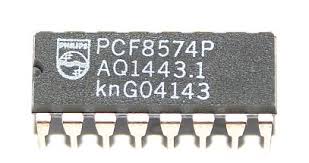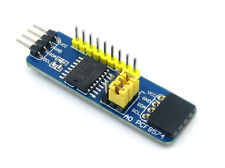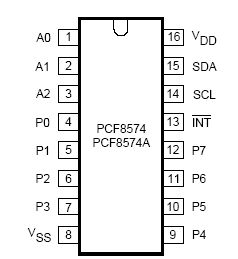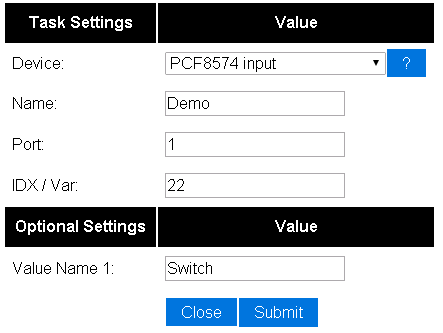Difference between revisions of "PCF8574"
| Line 152: | Line 152: | ||
[[ EasyValueNames | Use of value names]] | [[ EasyValueNames | Use of value names]] | ||
| − | + | = Output = | |
You can control output pins on this chip with the following http commands: | You can control output pins on this chip with the following http commands: | ||
| Line 160: | Line 160: | ||
| − | = Short Pulses = | + | == Short Pulses == |
You can also use the pulse command (precisely timed but delays the ESP) | You can also use the pulse command (precisely timed but delays the ESP) | ||
'''<nowiki>http://<ESP IP address>/control?cmd=pcfpulse,<pin>,<state>,<duration>(msec)</nowiki>''' | '''<nowiki>http://<ESP IP address>/control?cmd=pcfpulse,<pin>,<state>,<duration>(msec)</nowiki>''' | ||
| − | = Long Pulses = | + | == Long Pulses == |
You can also use the longpulse command (not quite as precise timing but non-blocking) | You can also use the longpulse command (not quite as precise timing but non-blocking) | ||
'''<nowiki>http://<ESP IP address>/control?cmd=pcflongpulse,<pin>,<state>,<duration>(sec)</nowiki>''' | '''<nowiki>http://<ESP IP address>/control?cmd=pcflongpulse,<pin>,<state>,<duration>(sec)</nowiki>''' | ||
Revision as of 15:18, 22 April 2017
Contents
Introduction
The number of GPIO pins on the ESP module can be expanded with a IO Expander. We will use the PCF8574 that provides 8 more pins that can be used as input or output. This way it becomes possible to control an 8 channel relay board.
Each individual pin can be used as either input or output.
Hardware
The PCF8574 needs to be connected through the I2C interface. This chip is compatible with 3V3 and therfore can be connected to the ESP without levelshifters.
Connections
PCF8574 ESP-01 GND ( 8) GND VCC (16) VCC SDA (15) GPIO 0 SCL (14) GPIO 2
Software
ESP Easy
Configuration depends on how you want to use a certain port on this device. Ports are numbered 1 to 8 (if you have a single PCF8574 connected)
Input
To have an input port act as an input switch device (just like with the default onboard GPIO pins) you need to edit a ESP Easy task and select the "PCF8574 input" device.
You then select the portnumber and additional configuration depending on the controller type. For Domoticz, you enter the IDX that was allocated by Domoticz for this virtual switch.
Portnumbering depends on the I2C address used:
For the PCF8574:
| A0: | A1: | A2: | Address: | Port range: |
|---|---|---|---|---|
| 0 | 0 | 0 | 0x20 | 1 - 8 |
| 1 | 0 | 0 | 0x21 | 9 - 16 |
| 0 | 1 | 0 | 0x22 | 17 - 24 |
| 1 | 1 | 0 | 0x23 | 25 - 32 |
| 0 | 0 | 1 | 0x24 | 33 - 40 |
| 1 | 0 | 1 | 0x25 | 41 - 48 |
| 0 | 1 | 1 | 0x26 | 49 - 56 |
| 1 | 1 | 1 | 0x27 | 57 - 64 |
For the PCF8574A:
| A0: | A1: | A2: | Address: | Port range: |
|---|---|---|---|---|
| 0 | 0 | 0 | 0x38 | 65 - 72 |
| 1 | 0 | 0 | 0x39 | 73 - 80 |
| 0 | 1 | 0 | 0x3A | 81 - 88 |
| 1 | 1 | 0 | 0x3B | 89 - 96 |
| 0 | 0 | 1 | 0x3C | 97 - 104 |
| 1 | 0 | 1 | 0x3D | 105 - 112 |
| 0 | 1 | 1 | 0x3E | 113 - 120 |
| 1 | 1 | 1 | 0x3F | 121 - 128 |
Optional settings
Output
You can control output pins on this chip with the following http commands:
http://<ESP IP address>/control?cmd=pcfgpio,<pin>,0
http://<ESP IP address>/control?cmd=pcfgpio,<pin>,1
Short Pulses
You can also use the pulse command (precisely timed but delays the ESP)
http://<ESP IP address>/control?cmd=pcfpulse,<pin>,<state>,<duration>(msec)
Long Pulses
You can also use the longpulse command (not quite as precise timing but non-blocking)
http://<ESP IP address>/control?cmd=pcflongpulse,<pin>,<state>,<duration>(sec)



